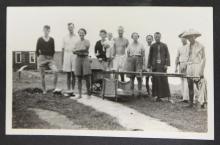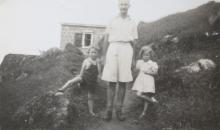As you near the top of Sunset Peak, you'll find 20 squat, grey buildings. If you're used to Asian beach holidays, you might find the description 'resort' a bit of a stretch. But that's how Denis Bray describes them, as he writes about life as a missionary's son in the 1930s [1]:
In these days of universal air conditioning it is difficult to appreciate the trials of the summer in Hong Kong, let alone the hotter and more humid conditions in South China. The typical tour for a missionary was five years followed by a furlough in England during which the missionary toured the country speaking about his experiences. During the hot summers missionaries' families would descend on the resorts of Hong Kong. Two were particularly popular — Cheung Chau and Sunset Peak on Lantau.
On Lantau a number of bungalows had been built and are still there. We slept in our bungalows but had our meals in the common dining room which was also used for meetings and services. As children we spent the whole time out of doors and swimming in pools in the streams. My most vivid memory of Lantau was being there in a typhoon. We must have had some warning of the approach of the typhoon as the shutters were closed, so that the lamps had to be lit — there was no electricity of course. We did not have long to wait before the storm hit. The noise was terrific and the wind blew quantities of water under the door into the bungalow It seemed to go on for a long time. The next day the shutters were opened, the lamps put out and we emerged into a battered but recognisable environment.
I've also received several interesting emails from Donald Ady, who is also a missionary's son, and who arrived in Hong Kong in 1938:
I went up via Tung Chung in 1938 (? maybe it was) and henceforth via Mui Woh, Silvermine Bay. The latter was a modest village then. The inter-island ferry paused offshore a short distance as there was no quay. A long boat rowed usually by one little old lady came alongside for passengers and baggage. She rowed with one long stern sweep oar with its handle connected to the deck by a rope and ring on the deck. Compound leverage was applied by pushing a foot horizontally on the rope. The boat ran aground and we jumped out on the sands. We accessed the first foothill beyond the village, then by crossing a series of narrow paths atop rice paddy field dikes.
The Laan Tau camp saddle had shacks, many of which were owned by missionaries originally. Most constructed out of cut black basalt blocks, topped by flat concrete roofs. Ours was the highest in camp near Sunset Peak.
A love of the fog is an acquired taste, one which I acquired myself there. But it does spoil the long view - especially perhaps in June or parts of July on Laan Tau. My wife stares at me as if I'd gone totally mad when I rave about that rare foggy day here in NJ, USA. Maybe you got your belly full in the fog? Proper dress in that is barefoot with nothing but wool sweater and trunks for the males. Clothes in a nearly airtight soldered tin box.
By coincidence I spent a weekend with a group of friends in one of those bungalows in the early 1990s. When we arrived the building was very chilly and damp. Inside it got better as the warmth from the people, lamps and stoves dried it out. But outside we were in the swirling clouds the whole time. The visit was arranged through a friend's church, so apparently the church connection remains. A friend suggests that they are now known as the Lantau Mountain Camp.
Donald also sent this link, which shows photos taken along the path from Mui Wo to Sunset Peak. You can see the buildings in the photo titles 'shelters on the ridge'.
Until a few weeks ago you could also zoom in to see the buildings using the Google satellite view above. However today I see they've updated the images, and the latest set put a large cloud over most of the buildings! Maybe the next update will reveal them again.
Does anyone else have any information or memories to share?
References:
[1] GROWING UP IN CHINA: LECTURE TO THE ROYAL ASIATIC SOCIETY, HONG KONG BRANCH, 14 MAY, 1993 by Denis Bray.



Comments
http://www.facebook.com/profi
http://www.facebook.com/profile.php?id=732664798&ref=nf#/group.php?gid=24026163991
there is a small open group on facebook. largely with an american missionary link (above) whose kids were at school in hk in the 70s. they also would invite other friends on these holidays - no, never went!
Thanks Vanessa,
some good photos there. I like this one for the 'then & now' view out towards the airport, and this one, for the 3-D map he's built!
Lantau Camp
I have spent many happy days living up on top of Lantau. Our family would spend summer vacations up there even before WWII. (I have a photo of my mother and I taken by one of the cabins, probably in 1939 or 1940.) My dad wrote a history of the camp that was published in one of the HK newspapers (not the South China Morning Post). I have it somewhere in my archives. In September of this year, my wife, sister and I hiked up to the camp from Nam Shan. It has not changed much over the years. It brought back many memories.
re: Lantau Camp
Scott, thanks for writing. If you find the history your dad wrote, would you mind posting it up for us to read, please?
Was he also a missionary? That seems to be the common link between other families who stayed there.
Regards, David
"An informal sketch of Laan Tau mountain camp"
Thanks to Michael for letting me know about this document. It gives a history of the camp from its founding in 1925. Here are some extracts:
The whole document is an interesting read, and can be downloaded from the Files section of the Lantau Mountain Camp group on Facebook. Thanks to William J Kyle for uploading it.
Regards, David
re: "An informal sketch of Laan Tau mountain camp"
Notes from Don Ady:
It was news to me that my Dad refurbished the water tank in 1957. That explains to me why the Google Earth view (the local snapshots or sky views) showed a changed structure. I suppose when the algae could not be readily cleaned out that at some point it was decided to do something about it. We did however fetch spring water in a bucket for drinking. When I used to fetch it in a white enamel pail, there was almost always one tadpole in it which my mother deftly removed in a cup. Dobson's Spring just around the ridge had a good sized "Dobson's Bath" just below the spring, but we used to spring source a short way above. Barely room for a small bucket when dipping, and tadpoles got caught by the flow going into the bucket.
The "Ady Shack" was the highest shack in the camp. Dad bought it from Dr. Dobson, also a Presbyterian missionary in Yeung Kong - and a fabulous character. Dobson had just the one room, with a miniature toilet and miniature "kitchen" large enough to stand in. Dad got the shack enlarged with a "sitting room", plus miniature additional bunk room and toilet/shower. The shacks had stout wood shutters closed with stout wood bars of about two by four inches cross section. The windows slid horizontally and loosely, and were fastened open with wood wedges. My father, the sort to stay busy, gave us brief camp visits which he often spent doing odd chores like repainting some wicker chairs.
I am not surprised that you reported that ((guerrillas)) had used the camp as a lookout. That is something which ought to have been done. BAAG tried to cooperate with the Reds to do that, but of political necessity had to check with the Kuomintang first, and the KMT angrily vetoed it. The mountain would have been the very best place to spot sea traffic in and out of the Pearly River. To get the information into Allied hands, there would have to have been some communication with my father who could send the information by radio. He once mentioned to me having seen a skein of ice on the mountain top in winter. I am now guessing that was in a visit to the guerrillas to provide advice for observations. Otherwise they would have needed to send a message with a guerrilla courier to Dad. First a sampan. Next, some "treasure hunt" to run down the always moving radio band my Dad was with. Probably there was some intermediary who more or less had some idea of where to look.
It was interesting to hear that Kennedy-Skipton was in charge of the trails. He apparently did a lot, as there were some large paving stones laid in here and there, postwar. He had been kicked out of the government postwar following a 1942 fall out with Gimson - office politics gone amok was my take on that. He owned a shack on the mountain near the central mess shack. When the Refo family (Presbyterians Henry, Sally, and daughters Alice-Ann, Peggy, Harriet, and Burney), they used Skipton's place. Mrs. Refo and Mrs. Skipton were good friends. I knew the Refos (but not the Skiptons) quite well.
Map of the huts on Sunset Peak
Click on any red marker to show the Place's name in a popup bubble. Click the name to see that Place's page, with related notes and photographs.
Better Map & Satellite view
Google's current choice of satellite photos for this area are covered in cloud (see above).
The HK Government's map service provides good alternative coverage of this area:
In both views, the swimming pool is at the bottom of the screen.
Regards, David
Re: Google had updated their images
Folks,
Google updated their images. The current version is showing clearly Sunset Peak with all the houses.
Best Regards,
T
LanTau Camp
My grandfather, J. Oscar Thomson, built one of the cabin up there back in the 20s. He was a missionary surgeon at the Canton Hospital and was looking for a summer place to send his family. They first tried a quonsey hut on the side of Tai Mo Shan in the New Territories but it was blown down in a typhoon. He built what is, or was at least in the 70s, cabin #6. He thought it was the best spot because it was in the middlle of the saddle on a slightly raised hill. His brother, Herbert Thomson, had another cabin down the hill closer to the swimming pool. My father went on and on about the summers he spent there in the 30s. He even sang a few songs the parents had made up about the place. I visited it a few times in the 70s when we lived in Hong Kong. The fog is almost as impressive as the view
Re: Lantau Camp
History on the Lantau Camp appears in the HK Telegraph dated 21 September 1940. See here Scroll to Page 6